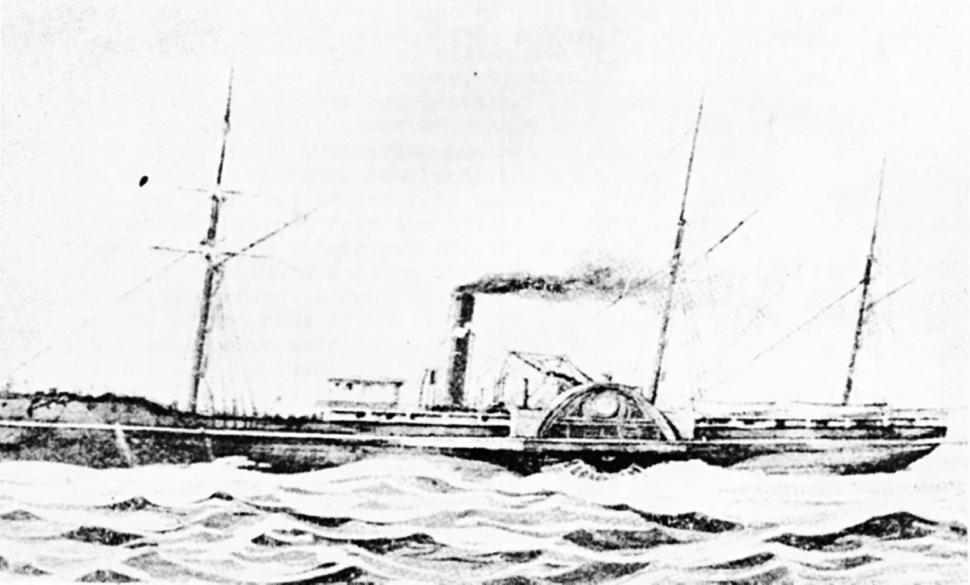The sinking of the SS Pacific in 1875, and the subsequent loss of 273 lives, is considered one of the worst maritime tragedies ever recorded on the Pacific coast. The ship collided with the S/V Orpheus while en route from Victoria, BC, to San Francisco, about 40 miles southwest of Cape Flattery, Wash.
The history of the SS Pacific
The SS Pacific was built in New York in 1850 as a side-wheel passenger steamship, weighing about 876 tons and measuring 223 feet long by 33 feet and six inches across the beam. This was a wooden0hull vessel that started its career by running between Panama and San Francisco during the California Gold Rush.
In September 1858, the ship began service between San Francisco and the Columbia River for the Merchants Accommodation Line.
On July 18, 1861, a foggy day, the ship was travelling down the Columbia River and struck Coffin Rock and sank. The ship was raised and pumped out, and then transported back to San Francisco for repairs. After being put back together, the ship continued service until 1872 and was then retired and left for rot in San Francisco Bay.
In the early 1870s, when gold was discovered on the Stikine River in the Cassier District in northern BC, the Pacific, and every other ship that could manage to float, was put back to work carrying miners and other individuals to Canada.
At that time, the Goodall, Nelson and Perkins Steamship Company, of San Francisco, purchased what was supposed to be a “reconditioned” ship, but in actuality, the repairs to the Pacific were only cosmetic. However, it was claimed to be completely rebuilt and seaworthy, and was also certified by the US Steamboat Inspection Service. The ship was approved to carry 203 passengers and a crew of 52. However, the ship only retained five lifeboats, with a carrying capacity of 160 people.
Thought to be as good as new, the Pacific set sail in the Pacific Northwest in April 1875 with Captain Jefferson Davis Howell at the helm. Howell was a veteran of the Civil War and brother-in-law to Jefferson Davis, president of the Confederate States. The Pacific was scheduled to run between San Francisco, Victoria, Seattle and Tacoma.
The day it sank
The SS Pacific departed from Esquimalt on Thursday, Nov. 4, 1875 at 9:30 a.m. – about half an hour later than it was scheduled. There was about 275 people on board, including crew, and passengers that ranged from prominent Victoria residents to wealthy businessmen, gold miners, an equestrian troupe and 41 Chinese labourers. The hold of the ship was also carrying quite a lot of cargo.
Once in the open ocean, there was a wind from the south and swells with whitecaps, which all contributed to slowing down the ship’s progress. By about 8 p.m. that night, the ship was about 12 miles from the coast of Washington and 30 miles south of Cape Flattery.
The night was overcast and rainy, and especially dark. The Pacific had three inexperienced crewmen on duty that night, and was running without port and starboard lights – only the white masthead light could be seen.

At that time, the Orpheus, a full-rigged sailing vessel weighing about 1,100 tons and measuring 200 feet long, with a wooden hull, was coming north along the Washington coast, travelling at about 12 knots. Around 9:30 p.m., the ship’s captain, Charles A. Sawyer, saw the Pacific approaching and turned his ship hard to port to try and avoid a collision. The Pacific continued to advance and only at the last minute tried to reverse its engines. Unfortunately, the Pacific struck the Orpheus on its starboard side, and two more times caving in the side planks.
Captain Sawyer focused all of his attention to the Orpheus, but his ship was not badly damaged. Once he knew the ship wasn’t sinking, Sawyer looked around for the steamer but it was gone.
The Pacific, on the other hand, was quickly filling with water from the breach in its hull. It didn’t take long for the ship to completely sink.
After the collision, the Orpheus crew worked through the night to make repairs. Unfortunately, the ship had drifted too far north in bad weather and Captain Sawyer mistook the light at Cape Beal for Cape Flattery. On Saturday, Nov. 6, the Orpheus sailed into Barkley Sound and ran aground on Tzartus Island. There were no casualties, but ship was destroyed. The crew and passengers of the ship made camp on shore and awaited rescue, which came on Wednesday, Nov. 10.
Survivors and aftermath
Only two men survived the sinking of the Pacific – Henry F. Jelley, 22, and Neil O. Henly, 21.
On Nov. 24, 1875, a Coroner’s Inquest was held in Victoria, BC, to investigate the incident. On Nov. 26, the coroner’s jury found the Orpheus crossing the Pacific’s bow had caused the collision, but the jury also censured the Pacific crew and officers for being negligent and incompetent in their duties. They also found that the steamer should not have sunk after such a collision, and therefore must have been in unseaworthy condition. Further, the ship didn’t have enough lifeboats for all of its passengers. The jury also declared Captain Sawyer guilty of manslaughter, for leaving the scene without trying to find out what had become of the Pacific. But nothing ever came of this verdict.

